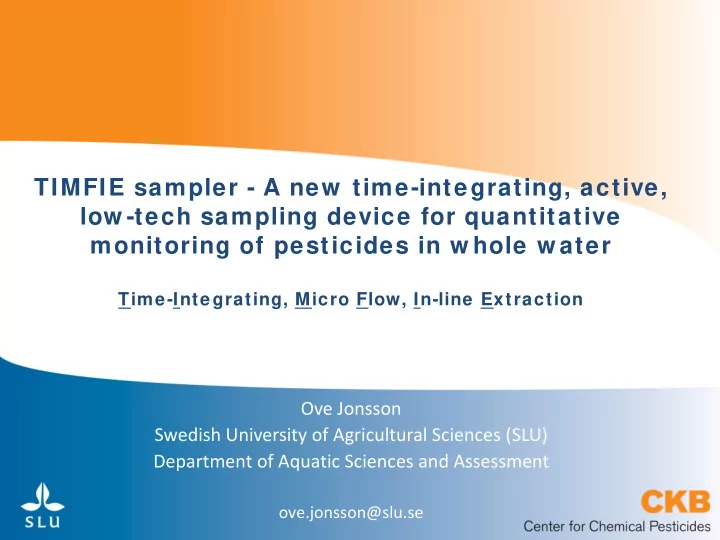

TIMFIE sampler - A new time-integrating, active, low -tech sampling device for quantitative monitoring of pesticides in w hole w ater Time-Integrating, Micro Flow, In-line Extraction Ove Jonsson Swedish University of Agricultural Sciences (SLU) Department of Aquatic Sciences and Assessment ove.jonsson@slu.se
Pesticide fate From: Water 2017 , 9 (7), 451 • Pesticide concentration in surface water will vary significantly over time • Average concentrations? Time proportional sampling. • Maximum concentrations? Event driven sampling. • Grab sampling will not answer these questions
Principle of the TIMFIE sampler Active sampling Flow restrictor: without battery or narrow bore PEEK tubing power supply 100 ml Continuous in-field SPE syringe (solid phase extraction) Filter Flow rate ∼ 3-6 µl/min Pull and lock piston. ( ∼ 60 ml in one or two weeks) Inlet Negative pressure tube drives the sampling
Quantitative analysis Accurate determination of extracted sample volume Photo: Ove Jonsson
Extracted volume over time (example) 120 100 ACCUMULATED VOLUME (ML) Linear range 0-80 ml R 2 =0.999 80 Sample volume 60 between 30-80 ml is preferred 40 20 0 0 1 2 3 4 5 6 7 8 9 10 11 12 13 14 15 16 SAMPLING TIME (DAYS)
Consumables Inner diameters of restrictors 75 100 125 µm 17+8 € 6 € 5+4 € 8+17 € 3 € 17+8 € Approximate costs: Start: 88-93 € Then: 7-12 €/sample Photos: Ove Jonsson Cut inlet tubing to a point shape to avoid stops
TIMFIE field application (examples) Photo: Roland Persson
Two weeks sampling Changes in water level Know your sampling site! Photo: Torbjörn Hansson, Grön Kompetens AB
Winter sampling (Sweden) entire sampler below surface to avoid freezing. TIMFIE mounted on a fishing-rod. Photo: Torbjörn Hansson, Grön Kompetens AB
Hiding the TIMFIE in a small stream (storm w ater) Syringe is hidden here Flow restrictor under stones SPE under this stone… …and inlet tube here… Inlet tube
Storm w ater w ells in urban areas Glyphosate and other urban used pesticide Dam to increase water height (Jeans leg with sand)
SPE possibilities Closed flow system, small format Stack cartridges in series to extract different compound classes Minimized solvent consumption Simple, inexpensive shipping and storage Rational internal standard addition Chromafix HR-P, HR-XAW and HR-XCW polymeric columns from Macherey-Nagel Photo: Ove Jonsson
Automation: Conditioning of SPE columns, 10 in parallel MeOH followed by H 2 O Quaternary LC pump
Automation: Elution of SPE columns, 6 in parallel Methanol, acetone and methanol with 80 mM ammoniac Evaporation in water bath at 40°C and N 2 flow. 50 µl DMSO as a keeper Dissolve in 3 ml ammonium acetate buffer at pH 5 Inject 0.5 ml
100 120 140 20 40 60 80 0 Hexytiazox TIMFIE absolute recoveries pesticides LC-(+ESI)MS Pyraklostrobin* Metrafenon Diflufenikan* Metamitron Oxadiazon BAM Indoxakarb* Bifenox* Prosulfokarb* Trifloxystrobin Metolaklor Metazaklor Isoproturon Pikoxystrobin Tiakloprid Spiking of three different surface waters, 4 replicates, n=12 Diuron Kloridazon Etofumesat Metalaxyl Acetamiprid Hexazinon Atrazindesetyl Atrazin 30 ml sample, error bars ± stdev, HR-P column Terbutylazindesetyl Terbutylazin Flurtamon Simazin Alaklor Propyzamid Fludioxonil Metribuzin O. Jonsson et al. Environ. Sci. Technol., 2019 , 53 (1), 279–286 Triallat Azoxystrobin Amisulbrom* Boskalid Quinoxyfen* Atrazindesisopropyl Siltiofam Klotianidin Pendimetalin Cyflufenamid Klomazon Cyprodinil* Cyanazin Linuron Mandipropamid Terbutryn Cybutryn Pirimikarb Karfentrazonetyl Metabenztiazuron Klorfenvinfos Tiametoxam Bitertanol Fenpropimorf* Pymetrozin Propikonazol Imidakloprid Dimetoat Fuberidazol Flusilazol Tolklofosmetyl* Flutriafol Penkonazol Epoxikonazol Difenokonazol Protiokonazol-destio Flufenacet Cyazofamid Fluopikolid Tritikonazol Fenpropidin* Florasulam* Spiroxamin* Fenmedifam Prokloraz* Metiokarb Tribenuronmetyl
% absolute recovery WAX-column in series w ith hydrophobic polymer TIMFIE absolute recoveries acidic pesticides LC-(-ESI)MS 100 120 20 40 60 80 0 2,4-D Bentazon Bifenox-syra Diflufenikan Diklorprop Flonicamid Florasulam Fluazinam Fludioxonil Flupyrsulfuronmetyl Fluroxipyr Jodsulfuronmetyl Karfentrazonsyra Klopyralid MCPA Mekoprop Mesosulfuronmetyl Metsulfuronmetyl Pikloram Propoxykarbazon Pyroxsulam Sulfosulfuron Tifensulfuronmetyl Triflusulfuronmetyl Trinexapak-syra
TIMFIE duplicate field sampling 1 9 duplicates, 156 data pairs, sample A vs sample B (µg/l ) 36 different pesticides found. Correlation (Pearson) r=0.998 Concentration sample A (µg/l) 0,1 0,01 0,001 0,0001 0,0001 0,001 0,01 0,1 1 Concentration sample B (µg/l)
TIMFIE vs grab sampling 10 218 data pairs, grab sample concentration calculated as mean of sample at start and end of sampling week. Mean value TIMFIE/grab = 1.7 (range 0.05-16.5). Correlation r=0.532 Concentration TIMFIE sample (µg/l) 1 0,1 0,01 Grab sampling is a poor substitute for time integrated sampling 0,001 0,001 0,01 0,1 1 Mean concentration grab sample (µg/l)
Summary TIMFIE sampling Pros Cons • Time integrated sample 1-2 weeks • No pH adjustment • Whole water • Restricted sample volume • Quantitative • Pre-concentration • Validation process according to established procedures • Flexible, different SPE materials Translate current SPE methods to TIMFIE conditions • Small format, flexible application • Transport and storage • Inexpensive • Use syringe water for further analysis
Acknow ledgement Swedish EPA and the Centre for Chemical Pesticides for financial support Colleagues at the Swedish University of Agricultural Sciences (SLU): Elin Paulsson, Henrik Jernstedt and Jenny Kreuger
Thank you for your time! Photo: Therese Nanos
Recommend
More recommend